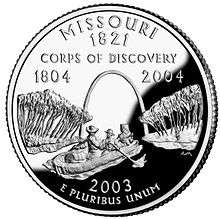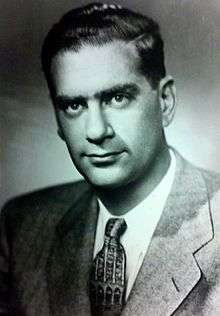Louisiana Purchase Sesquicentennial Commemorative Half Dollar

The Louisiana Purchase Sesquicentennial half dollar was a proposed United States commemorative coin. Put forward in 1952 by both the Missouri Historical Society (MHS) and the Louisiana Purchase 150th Anniversary Association, the coin was intended to celebrate the 150th year anniversary of the Louisiana Purchase.[1] Although a similar coin had been commissioned in 1903 to celebrate the centennial anniversary of the Louisiana Purchase, the sesquicentennial half-dollar failed to go into mint after objections from President Eisenhower.[2]
Background
The Louisiana Purchase conveyed to the United States over a million square miles of previously French territory for the price of $15 million. The Purchase was ratified by the U.S. Senate on October 20, 1803, and the new land subsequently doubled the size of the United States and opened the door to a new period of westward expansion.[3] Nearing the one hundred year anniversary of the Purchase in 1902, President Theodore Roosevelt signed a bill which authorized the Louisiana Purchase Exposition, which would become known as the St. Louis World Fair, to celebrate the Purchase and the past years of American history. This included the authorization of the creation of gold one-dollar pieces to be created as commemorative coins.[4] These pieces would go on to be circulated within the American numismatic community after the World Fair in 1904. The Louisiana Purchase Exposition dollar was one among many commemorative coins which had been authorized by the United States government since 1892, as centennial anniversaries of important events in early U.S. history were regular occurrences around this time.
Origins and development

Nearing the 150th anniversary of the Louisiana Purchase, similar efforts began to arise to commission a sesquicentennial commemorative coin. Eric Newman, a numismatist and active member of the Missouri Historical Society at the time, began writing to members of Missouri's government to advocate for a commemorative half-dollar piece. By September 1952, this eventually lead to a regular correspondence with Thomas B. Curtis, the Republican congressman for the Missouri 12th District, who became involved into the political effort to sponsor such commemorative pieces.[2]
Legislation
By April 30, 1952, a bill had been sponsored in the House of Representatives by future Democratic Majority Leader Hale Boggs to authorize the creation of a special coin to celebrate the sesquicentennial anniversary of the Louisiana Purchase.[5] With advocacy from Newman, Congressman Curtis also sponsored a bill in February 1953 to push the effort through the Banking and Currency committee.[6] With efforts from Curtis, backed by publicity efforts from the Missouri Historical Society, and Boggs, supported by the New Orleans-based Louisiana Purchase 150th Anniversary Association, the bill for a sesquicentennial coin was passed through committee and the House of Representatives by April 1953. The bill included plans to mint several hundred thousand special commemorative coins, the proceeds from the sale of which would be used to pay for the cost of a Louisiana Purchase celebration.[7] Some tension arose between the Missouri Historical Society and the Anniversary Association over details on which organization would receive the minted commemorative coins and the responsibility of distributing them. This was resolved with an amended bill that split the responsibility between the two lobbying groups, with more coins to be minted as well.[8] The bill authorizing coins to commemorate the 150th anniversary passed the Senate in January 1954, although for several million pieces instead of the few thousand initially called for by Eric Newman.
Fate
Although the lobbying process for a sesquicentennial commemorative coin began before the 1952 presidential election, by the time the bill had passed the House and Senate it was well into the Eisenhower presidency. President Eisenhower was a moderate Republican wedded to conservative fiscal ideas that stressed the importance of balancing the budget, and often was suspicious of bills authorizing greater expense without clear, tangible projected results.[9] Consequently, Eisenhower vetoed the bill for the commemorative coin. Among other things, Eisenhower cited a lack of public interest in the Louisiana Purchase 150th anniversary, the possibility of facilitating counterfeit coins with so many minted half dollars, and the many organizations which would lobby for their own commemorative pieces for other events if Eisenhower authorized the half dollar coin.[10]
The veto of the proposed sesquicentennial commemorative coin marked the nearing of the end of the United States "classic commemorative" coin period which began in 1892. Only one more commemorative coin, the Washington-Carver half dollar, would be authorized in 1954 before a several decades long absence of minted commemoratives, until 1982 when a new period of minting commemorative coins began.[2]
References
- ↑ "Louisiana Purchase Sesquicentennial Celebration: Commemorative Half Dollar Correspondence, 1952-1954". Newman Numismatic Portal. Washington University in St. Louis. Retrieved 24 May 2017.
- 1 2 3 "The Louisiana Purchase Half Dollar That Wasn't". E-Sylum. Numismatic Bibliomania Society. Retrieved 25 May 2017.
- ↑ Slabaugh, Arlie R. (1975). United States Commemorative Coinage (second ed.) (2 ed.). Racine, WI: Whitman Publishing. p. 23.
- ↑ Swiatek, Anthony; Breen, Walter (1981). The Encyclopedia of United States Silver & Gold Commemorative Coins, 1892 to 1954. New York: Arco Publishing. p. 120. ISBN 978-0-668-04765-4.
- ↑ Newman, Eric (January 9, 1953). "Congratulations" (Letter). Letter to Thomas B. Curtis. Retrieved May 27, 2017.
- ↑ Curtis, Thomas (February 4, 1953). "Bill for the Sesquicentennial Coin" (Letter). Letter to Eric Newman. Retrieved May 27, 2017.
- ↑ Weiss, Seymour (April 8, 1953). "Letter of March 27th" (Letter). Letter to Eric Newman. Retrieved May 27, 2017.
- ↑ Weiss, Seymour (June 16, 1953). "The Senate Bill" (Letter). Letter to Eric Newman. Retrieved May 28, 2017.
- ↑ Ambrose, Stephen; Brinkley, Douglas (2011). Rise to Globalism (9 ed.). New York: Penguin Group. p. 129.
|access-date=requires|url=(help) - ↑ Dwight D. Eisenhower (February 3, 1954). To the House of Representatives (Report). Retrieved May 28, 2017.